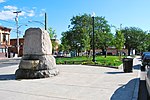Knox Street Historic District

The Knox Street Historic District is primarily located along one block of that street in the Park South neighborhood of Albany, New York, United States. Its contributing properties are several groups of attached rowhouses. The area was recognized as a historic district and listed on the National Register of Historic Places in 2008.For most of the first half of the 19th century, the block of Knox that comprises most of the district was either undeveloped or used as a nursery by Scottish-born James Wilson, breeder of one of the early American-bred commercial strains of strawberry. His 1830s Federal style house on Morris Street is a contributing property, the oldest in the district and one of the oldest in Park South. The nursery remained in operation in some capacity into the early 20th century under different ownership. Most of the rowhouses were built in the 1870s and -80s, probably by the same builder, as they are a more cohesive group than other clusters of rowhouses in Park South. They also include a set with corbelled brick and projecting bays, both unusual architectural features for Albany rowhouses. All buildings in the district are brick; only two are detached houses. The rehabilitation of the properties, which had fallen into disrepair, won an award from the state Office of Parks, Recreation and Historic Preservation in 2009.
Excerpt from the Wikipedia article Knox Street Historic District (License: CC BY-SA 3.0, Authors, Images).Knox Street Historic District
Knox Street, City of Albany
Geographical coordinates (GPS) Address Nearby Places Show on map
Geographical coordinates (GPS)
| Latitude | Longitude |
|---|---|
| N 42.653127777778 ° | E -73.770583333333 ° |
Address
Knox Street 140
12208 City of Albany
New York, United States
Open on Google Maps










